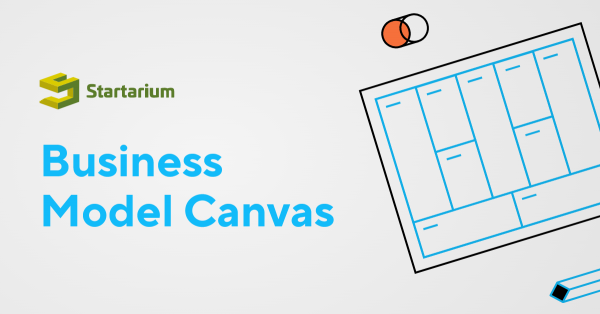Before you start selling, you need to clarify your business model and simulate how it will actually work. Basically, you have to make some decisions about how you will manage the activity, the resources you need and the growth opportunities they open up. Here's what you need to know about the business model and business plan.

How can I earn the money I need to serve even more clients? The business model is your recipe to succeed in doing this every day, through good (enough) decisions on the 9 strategic topics of the business model canvas.
But what is really important in the beginning is to understand your options and their impact on the first 2 big challenges of entrepreneurship:
-
the right product for the right market
-
viable business model
The “product-market fit” basically means you need to have the right product for the right markets.
The first challenge you have is to make sure that your offer has real value for the customer segments you are targeting. Here are some important things you can do to solve this challenge.
Steps to follow for the business plan
1. Explore all possibilities
Organize a brainstorming regarding the customer segments and compare them (how many are there? Which ones can you reach more effectively? do they have resources?)
-
Think about different variants of your product.
-
Look for all the products that your customer can use to say "done, I’ve solved it" (even if they are very different from your solution).
-
Research all possibilities to promote and monetize your business.
-
At the end, draft several business models and validate them one by one, including through the following actions.
2. Interview your (potential) customers
Find out all about what your customers are doing now to "solve” their problem, why they make those choices and what frustrations they have every step of the way. Super tip: use open-ended questions and be very curious.
3. Make prototypes
Sketch, build, or offer your product to test the assumptions you've made and discover things you may not even have thought of.
Don't set limits when thinking about what a prototype means, as it can take forms such as:
-
a wireframe / sketch
-
an "ugly" but functional version
-
a presentation material
-
a user storyboard
-
a demo experience
-
a full "shelf-ready” version
-
an ad that tests the customers’ reaction to your idea
4. Expose the customers to your prototype
The simpler the prototype, the more incomplete the information you get, but it's better to discover early which of your assumptions are unrealistic.
5. Build a complete experience
The way customers discover you, decide, buy and even "get rid" of what you have offered them are as important as the product itself. Make sure that what you build is built around their behaviors and habits.
The viability of the business is half solved if find a good product-customer and sales process combination.
All you have to do then is to organize the business so that:
-
the interaction channels and the monetization model make the sale and the customer relationship easy, efficient and repeatable
-
the costs generated by the activities, resources and partners you need do not exceed the income
Here are some important things you can do to solve this challenge.
-
"How I pay" is more important than "how much I pay": First of all, understand which monetization model is more suitable for your customers: subscriptions - per month or per user? simple purchase? rental?, etc. Then find out how much they are willing to pay.
-
Understand what it means to sell and how much it costs: Read, study or ask what different channels and approaches can do (and especially, what they CANNOT do) for your business and what their costs are.
-
Be aware of the costs: For every potential business model, make a list of the costs and start to estimate or find out how much they might be. Don't get stuck on having a complete or correct list - what is more important is to have a "living" document that evolves along with your decisions.
-
Estimate the income: Estimating the income is the hardest exercise, especially when you don't have enough information. What you can do, however, very early on, is learn how to model different business models in a spreadsheet and add information and estimates, just as you do with the costs - as you better understand the market reality.
-
Compare the costs and income: It may seem like an obvious exercise, but many entrepreneurs do it too late. Even if you do it with little (and wrong) data, it can show you in advance why some business models seem obviously unviable and what decisions can save them.
Where does the business plan fit into this story? When should I do it?
First of all, let's get something straight:
-
Business planning is the process whereby you make decisions like the ones mentioned above and "learn" everything you need to know about your business or industry.
-
The business plan is a tool you use to "say" which decisions you are betting on.
That's why business planning is what you do day after day after day - whether it's daily decisions, or decisions about everything you'll do during the next two years, for example. The business plan? Well, you will use it when you need to better communicate or visualize your decisions.
Tips that apply to most entrepreneurs:
-
Make sure you progress towards the point where you sell something. In most cases, the mistakes you make when you actually sell something are more useful than the ones you make on paper.
-
A solid business "general culture" helps you find new possibilities and solutions more easily. So learn about technologies, markets, approaches, business models and products from various industries – and not JUST when you're getting ready to launch your product.
-
Even if you have a product that has been "confirmed" by your first customers, don't expect to attract customers only by paying. Paid marketing channels have become too expensive to be the only solution, so think of a business model that brings customers to you through other methods - word of mouth, organic, partnerships, etc.
-
But don't underestimate the investment required to attract customers. Without a consistent marketing budget, it will be difficult - if not impossible - to “spread your wings".
-
Just remember to make this investment after you've found pretty good answers to the rest of the business model questions. Until then, wise marketing expenses are nothing but experiments.
Lucian Grămescu is Head of Operations RGT Cycling and a consultant with more than 10 years of experience in business incubation.























